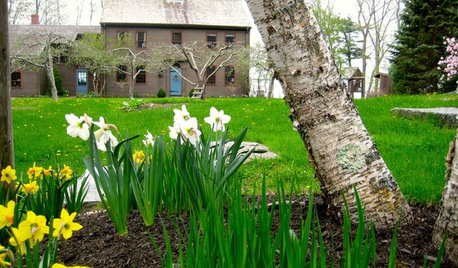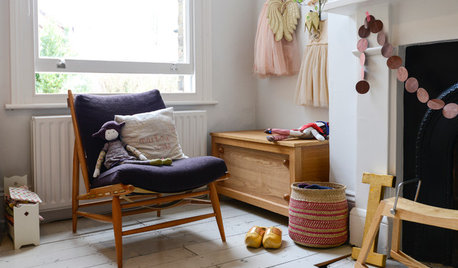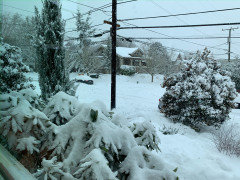Cold Climate Heat Pumps
simmtalker
5 years ago
last modified: 5 years ago
Featured Answer
Sort by:Oldest
Comments (72)
fsq4cw
5 years agoAvatarWalt
5 years agoRelated Discussions
Carrier Greenspeed 25VNA Heat Pump Electricity Usage in Cold Area
Comments (43)Hi All. Live in eastern Ontario and just got installed a Greenspeed 25VNA048 heat pump w a 59MN7080 gas furnace to stop paying for oil. It was a learning curve for this system as it is an advanced heat pump system - expect the competition to ramp up their pumps HSPF to 13 also or lose the market. My coldest night so far was -15C and we got our 21C/70F indoor temp in our 2800 sq.ft house.My balance point is set for -17C/1F and I should be getting to -18C this wed/Thurs evening for a real test for the normal switch to gas furnace. Yes the system by default uses gas heat on defrost. Without it it would be blasting cold air in the ducts for 5 minutes. So the gas frnace heat modulates at 65% so to neutralize the cold air so air temp swings are minimum for comfort. Yes you can disable this on the touch screen interface in service/ setup/ heat source lockouts. Yes one can monitor electrical costs in $$$ or Kw and gas $$$ or therms on a per day/ per month and per year to date on the interface. I've experimented between the different options in choosing efficiency or comfort and there is a noticeable difference to the environment and a slight increase in costs of electricity between the two. I do prefer comfort. On an average cold day 0C/32F w -5C at night it costs me @ $5 per day in electricity and with heat on defrost w/ continuous low fan for only an additional cost of $1 every third day (.33cents per day). (yes the different areas of kw usage is separated in the readout) The only puzzle I have to resolve is last Saturday nite at 3 am the house felt cold - it was 15 F outside. Gas furnace came on for a couple of hours before pump came back ???. No codes or resetable fault codes registered on interface. The only way for the gas to go on at that temp way above the balance point is a 2 degree drop or a manual increase of temp of 2 degrees or more. So why did did happen.... stay tuned.... Gotta love saving money. Last year in October it cost me $425 in oil - this year for Oct gas+electrical $202 Included is a pic Update Jan 2014: had issues w furnace overiding heatpump prematurely and Carrier change my thermostat which had Version 9 to version 10 software - issue fixed. those who want to see what savings a heat pump can have over your specific system try this: http://sagoro.wrightsoft.com/Carrier/Default.aspx This post was edited by Cocobob on Mon, Jan 13, 14 at 23:22...See MoreIs it smart to use radiant heating on 1-floor and heat pump on 2nd?
Comments (14)If the house is designed to current IECC energy codes or better, the 1st level radiant could probably handle most of the home's heating loads including 2nd level. If upfront costs and operating costs are important, you may want to reconsider radiant floors and propane as main energy source. Here is [recent thread on propane[(https://www.houzz.com/discussions/energy-star-most-efficient-2019-boilers-help-reading-the-stats-dsvw-vd~5649781?n=36) boilers. To summarize, propane is the most expensive common fuel. It would cost less to heat your home using electricity, as long as you choose high efficiency heat pump options. Cold climate heat pumps are available for your climate so choose a contractor who is comfortable with them and follow their guidance on any needed backup. Tough to beat woodstove with frequent power outages. Radiant only provides heating so it's a tougher choice if the upgrade costs are worthwhile in your climate. Cold climate heat pumps can satisfy heating needs with generally less upfront costs. Ductless heat pumps are packaged systems that are easy to install. Providing sweat equity for radiant floors will be needed to compete in upfront costs. Tubing, manifolds, pumps, appliances, controls, pipes, all done in custom snowflake fashion. Giant propane tank, piped fos$il fuels into house, combustion exhaust to expel, hopefully not backdraft. Most people choosing radiant are going off experience based on inefficient homes. Building to current codes changes the comfort dynamic and some find radiant less comfortable due to thermostat delay response. Radiant floors rarely make economic sense for efficient homes....See MoreIs there a reliable HVAC cold climate heat pump with hot water tied in
Comments (11)Condensing hot water heater or furnace are probably not an option. Living in a condo, I can't add in a horizontal PVC exhaust since it would change the look of the condos. A vertical one would need to be at least 30 feet long and not sure if they'd ok a new roof vent considering we just had our roofs redone over the summer. The Flue pipe issue. The flue is shared with my downstairs neighbor. It of course runs through a chase through my 2 floors and out the attic. There was a very minor noise issue when they had a yapping dog when it was standing in a certain area, but not an issue any more. Problem is the original builders (Hovnanian) are incompetent at best. The chase also has my neighbors 2 MUA vents and my HVAC return ducts. They put the flue and MUA vents in the wrong place and left hardly any room for the return air. Long story short, space is limited, access to move stuff around is limited, if I don't have to share the flue pipe I can install a smaller size one when I attempt to move it over leaving more space for new return air ducting. This picture is the piece of duct between my return air plenum in the chase connecting to the filter box next to my HVAC unit. You can see the great job they did sealing it. Can't see it but the flue pipe is only an inch or 2 to the left of it. It's an 8 X 20 duct which is about half the size needed from my over 1400 CFM HVAC unit, If you don't over size it by 20 to 25% that people often do for the returns.. Side note, the chase is supposed to be fire rated and all penetrations are supposed to be fire sealed....See Morereplace steam boiler(and what about A/C) or convert to heat pump?
Comments (13)"In terms of the Bosch I doubt it would make much difference if you sized it for heating... unless you needed more heat than a 5 ton unit can produce." Name plate capacity of a heat pump refers to cooling mode only. The term "ton" refers to a ton of refrigeration which is 12,000 BTU/hr. Heating capacity is usually referred to in BTU/hr. The heating capacity of a heat pump declines as a function of decreasing temperature, so it can't be labelled without defining the outdoor conditions. Stated otherwise, a 5 ton heat pump does not have the same heating capacity as a 60,000 BTU/hr furnace--the capacity of which is independent of outdoor conditions. "However, the Bosch can deliver heat down to 5F." That statement can be a bit misleading. While a particular heat pump may be able to extract useful heat down to 5F, that doesn't guarantee it will be able to do so at a sufficient rate to meet the required heating demand without supplemental (backup) heating e.g., electric resistance heat strips. When evaluating a heat pump in heating mode, we're interested in determining the balance point--the outdoor temperature at which the heating load of the home and heating capacity of the system are equal. Below that temperature supplemental heating will be required. For most heat pump systems and most homes (excluding uninsulated homes and super-insulated homes) the balance point usually falls in the 30 F to 35 F range. To be clear, that doesn't mean a particular heat pump won't extract useful heat below that temperature---it just means the amount of heat won't be sufficient to meet the total heating load required and backup heat will be needed. I suggest you consult with an HVAC design professional who can calculate the heating and cooling loads for your particular home and your particular climate zone. Those can be used to select the appropriate equipment and to design the duct work if you elect to go with a ducted system. And, for what it's worth, mike_home has been a contributor to this forum for a number of years. In general, his posts suggest that he knows what he doesn't know. That's more than I can say for some "professionals" here on houzz.com...See Moreweedmeister
5 years agomtvhike
5 years agosimmtalker
5 years agosimmtalker
5 years agoionized_gw
5 years agoionized_gw
5 years agoAvatarWalt
5 years agooneandonlybobjones
5 years agolast modified: 5 years agoionized_gw
5 years agooneandonlybobjones
5 years agolast modified: 5 years agosimmtalker
5 years agosimmtalker
5 years agoionized_gw
5 years agomike_home
5 years agosimmtalker
5 years agosimmtalker
5 years agosimmtalker
5 years agoionized_gw
5 years agolast modified: 5 years agomike_home
5 years agooneandonlybobjones
5 years agolast modified: 5 years agosimmtalker
5 years agoionized_gw
5 years agooneandonlybobjones
5 years agolast modified: 5 years agoionized_gw
5 years agosimmtalker
5 years agomike_home
5 years agolast modified: 5 years agosimmtalker
5 years agomike_home
5 years agosimmtalker
5 years agosimmtalker
5 years agoMiniSplit Heat
5 years agoCollin B
2 years agosktn77a
2 years agosimmtalker
2 years agolkthompson97520
last yearAvatarWalt
last yearlast modified: last yearAndrew Arnsberg
last yearPoorgirl
last yearCharles Ross Homes
last yearpoorgirl
last yearmcarroll16
4 months agoAvatarWalt
4 months agoAndrew Arnsberg
4 months agomcarroll16
4 months agoAvatarWalt
4 months agomcarroll16
4 months agoPoorgirl
4 months ago
Related Stories

WORLD OF DESIGNWorld of Design: These Gardeners Dig Cold Climates
Passionate gardeners in Maine, Russia and northern Sweden know how to get the most from their short growing seasons and freezing conditions
Full Story
ARCHITECTURE15 Smart Design Choices for Cold Climates
Keep your home safe and comfortable in winter by choosing the right home features and systems
Full Story
GREEN BUILDINGBuilt for Energy Efficiency in a Cold Climate
This Calgary, Canada, duplex is LEED Platinum-certified despite the area’s freezing weather much of the year
Full Story
GARDENING GUIDES10 Cold- and Heat-Tolerant Perennials and Shrubs for the Arid West
These flowering native plants shrug off the cold of winter and heat of summer while adding beauty to the drought-tolerant landscape
Full Story
FEEL-GOOD HOMESimple Pleasures: Get Cozy on a Cold Day
Some things are best when the weather is bad. Heat up some cocoa and join the discussion
Full Story
BATHROOM DESIGNWarm Up Your Bathroom With Heated Floors
If your bathroom floor is leaving you cold, try warming up to an electric heating system
Full Story
GARDENING GUIDES10 Cold-Hardy Succulents for Cool-Season Interest
These attractive plants shrug off colder temperatures, and many can be brought inside in containers in extra-chilly climates
Full Story
HOUSEKEEPINGLower Your Heating Bills With Some Simple Weather Stripping
Plug the holes in your house this winter to make sure cold air stays where it belongs: outside
Full Story
DECORATING GUIDES6 Warm Touches From Homes in Cold Places
Tips gathered from this week’s stories about homes in freezing climates show how you can find warmth in winter
Full Story
FLOORSFloors Warm Up to Radiant Heat
Toasty toes and money saved are just two benefits of radiant heat under your concrete, wood or tile floors
Full Story




fsq4cw